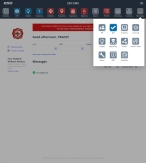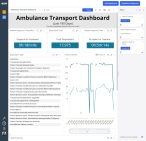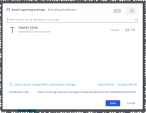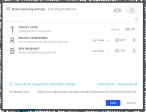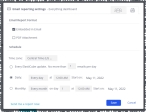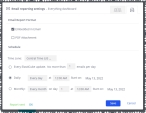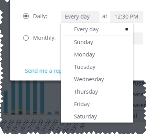Email dashboard information
You can send the contents of a dashboard in a secure, encrypted email whenever needed, and you can configure a recurring email subscription that automatically sends the dashboard information either daily or monthly, at a specific time of day.
Note: You must have a designer role assigned to you in the ESO Insights module to configure settings for emailing dashboard information, and you can only email information for dashboards you are the owner of.
Information on role assignments is available in Assign user roles in the ESO Insights module.
-
 (If you have not done so already) Access the ESO Insights module in the ESO Suite.
(If you have not done so already) Access the ESO Insights module in the ESO Suite.
-
Do one of the following.
-
(If you are already working in the ESO Suite) Click the Home icon in the upper left corner of the screen.
-
 (If you have not yet logged in) Log in to the ESO Suite.
(If you have not yet logged in) Log in to the ESO Suite.
-
In a web browser, go to https://www.esosuite.net/EsoSuite.
The ESO Suite login screen appears.
-
Enter your user name, password, and agency name, then click Let's Go.
If MFA is enabled, the Multi-factor authentication dialog box appears, displaying one or more methods you can use to verify your login credentials. The number of methods that appear in the dialog box depends on what MFA methods your ESO Suite administrators enabled in the Admin module.
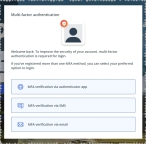
Click graphics
to open them.Information on enabling MFA and specific MFA methods is available in the Admin module online help, in Configure multiple-factor authentication.
Note: If your ESO Suite administrators have disabled MFA ("opted-out"), this dialog does not appear.
-
(If the Multi-factor authentication dialog box appears) Depending on which buttons appear in the dialog box, verify your login in one of the following ways.
 With an authenticator application.
With an authenticator application.
-
Click MFA verification via authenticator app.
The dialog box updates with boxes for entering the numbers of the authentication code, and the ESO Suite sends an authentication code to the authenticator application installed on your device.
-
Open your authenticator application and note the authentication code currently displayed.
-
Enter the authentication code displayed in the authenticator application.
-
Click Log In.
 With a text message (SMS).
With a text message (SMS).
-
Click MFA verification via SMS.
The dialog box updates with boxes for entering the numbers of the authentication code, and the ESO Suite sends an authentication code to the phone number recorded in your PM records and identified with MFA codes.
-
Enter the authentication code sent to your MFA-registered phone number.
-
Click Log In.
 With an email message.
With an email message.
-
Click MFA verification via email.
The dialog box updates with boxes for entering the numbers of the authentication code, and the ESO Suite sends an authentication code to your agency or department email address, recorded in your PM records.
-
Enter the authentication code sent to your agency or department email address.
-
Click Log In.
-
-
The ESO Suite landing screen appears.

Click graphics
to open them.Note: If MFA is enabled, you can access and manage your MFA options through the PM module, on the Settings > Account page, as described in Manage a user account. If your agency or department has enabled MFA but has not purchased the full-featured version of the PM module, you can access your own MFA settings by clicking Change my Multi-Factor Authentication settings on the landing screen, then using the Settings > Account page that appears. If your agency has not enabled MFA, the Change my Multi-Factor Authentication settings link does not appear on the landing screen.
-
-
On the top side of the home screen, click Insights.
Tip: If your screen or browser window is too narrow to display all your agency's ESO Suite module icons, an options icon appears on the right side of the icon bar. If you click the options icon, a menu appears containing additional module icons.
-
A list of all the dashboards in the ESO Insights module appears.
The capabilities you have in the ESO Insights module depends on what roles and permissions your ESO Suite administrator assigned to your user account. It also depends on what roles your ESO Insights manager assigned to your user account within the ESO Insights module.
Information on user accounts, roles, and permissions is available in Manage a user account. Information on roles assigned with the ESO Insights module is available in Assign user roles in the ESO Insights module.
-
-
Click the name of the dashboard you want to work with.
Tip: If the list of dashboards is long, you locate the dashboard you want more easily, as described in Find and open an existing dashboard or report.
The dashboard opens and displays any widgets it contains, and the data those widgets link to.
Click graphics
to open them. -
In the dashboard title bar, click the share icon.
Note: This icon appears only for dashboards you are the owner of.
The Email reporting settings dialog box appears.
-
 Choose who the dashboard information is sent to.
Choose who the dashboard information is sent to.
-
(If it is not already selected) Click the people (
 ) tab.
) tab. -
In Enter names, email addresses or groups, type the name or email address of the people or groups you want to send this dashboard’s information to.
The additional names or email addresses appear in the dialog box, and these people or groups are granted viewer access to the dashboard.
-
(If necessary) For any person or group you want to remove from the list, on the left side of that person's listing, click the delete (
 ) icon.
) icon.
-
-
 Determine who receives the information as a recurring email.
Determine who receives the information as a recurring email.
-
(If it is not already selected) Click the people (
 ) tab.
) tab. -
For each person or group in the list, click the email subscription (
 ) icon to indicate whether that person or group should receive the dashboard information as an automatic, recurring email or not.
) icon to indicate whether that person or group should receive the dashboard information as an automatic, recurring email or not. Tip: To quickly set every person or group in the list to subscribe or unsubscribe from a regular email of the dashboard information, in the lower right corner of the dialog box, click Subscribe All or Unsubscribe All.
Note: By default, people or groups that you add to the list and subscribe to an automatic email for the dashboard information can not unsubscribe themselves from receiving the emails, change their delivery date and time, or the frequency with which they are sent the information. You have the option to relax the subscription control and let people manage when and how-often they receive the dashboard information.
-
(Optional) In the lower left corner of the dialog box, click Users cannot change their subscription settings.
The lock icon to the left of the option changes to an unlock icon, and the option name changes to Users can change their subscription settings.
-
-
 Select the format for the information.
Select the format for the information.
-
(If it is not already selected) Click the email subscription (
 ) tab.
) tab. The tab opens, displaying fields for configuring the dashboard information settings and recurring emails as a subscription service
-
Under Email Report Format, select or clear Embedded in Email or PDF Attachment to indicate how you want the dashboard information sent with the email.
-
 (Optional) View the PDF file as it would appear as an attachment to the email.
(Optional) View the PDF file as it would appear as an attachment to the email.
-
Hover your mouse pointer over PDF Attachment, then click Edit/View PDF Report when it appears.
The PDF Report Settings dialog box appears.
-
From Paper Size, choose the paper size the PDF file should be sized to fit on, in case it is printed in the future.
-
For Orientation, choose whether the PDF file should display the dashboard information in Portrait (narrower and longer) or Landscape (wider and shorter) mode.
Depending on the size of the screen you or someone else uses to view the PDF file you download, your width choice in this dialog box may improve the viewability of the file. If the file is printed in the future, this choice may also affect the presentation of the dashboard on paper.
-
In Header, select which elements of the of dashboard's title bar to include in the PDF file, and to indicate whether or not the right pane of dashboard filters should be included in the PDF file.
-
In Footer, select or clear Page Number to indicate whether or not to include page numbers in the PDF file footer.
-
In the upper left corner of the preview pane, drag the slider to View mode or Edit mode, to indicate whether or not the PDF file can be edited after you download the dashboard information to it.
-
At the bottom of the dialog box, to the right of Save, click the download icon.
A confirmation dialog box with a progress wheel appears as the ESO Insights module captures the dashboard's data. The file downloads to the default download location, and saves with the file name <dashboard name> <date>
.pdf.
-
-
-
 Schedule when to send the information.
Schedule when to send the information.
-
(If it is not already selected) Click the email subscription (
 ) tab.
) tab. The tab opens, displaying fields for configuring the dashboard information settings and recurring emails as a subscription service
-
Depending on when you want to send the information, do one of the following.
 Send the information immediately.
Send the information immediately.
-
In the lower left corner of the dialog box, click Send me a report now.
The message Sending ... appears in the lower left corner as the ESOInsights module captures the dashboard's data. The Report Sent message and OK then appear in the lower left corner of the dialog box, and the ESO Insights module mails the information in the format you selected earlier.
-
Click OK.
 Schedule a recurring email subscription.
Schedule a recurring email subscription.
-
Under Schedule, from Time Zone, choose which time zone the ESO Insights module should use when sending to automated emails.
-
Indicate how often the ESO Insights module should send the email, in one of these ways.
 Daily or weekly
Daily or weekly
- Choose Daily.
-
To the right of Daily, from the first field, choose either Every day, or the day of the week you want the ESO Insights module to send the automated dashboard information.
-
For the second field, choose the time of day to send the information.
-
In Start on, click the field and select the appropriate date from the calendar that appears.
 Monthly or yearly
Monthly or yearly
- Choose Monthly.
-
To the right of Monthly, from the first field, choose either Every month, or the month you want the ESO Insights module to send the automated dashboard information.
-
For the second field, choose the calendar day to send the information.
-
For the third field, choose the time of day to send the information.
-
In Start on, click the field and select the appropriate date from the calendar that appears.
Note: ElastiCube is a proprietary analytics standalone database that queries run against when displaying data for the dashboard. Because the ESO Insights module supports live data models, not standalone databases, you can not choose the Every ElastiCube update option.
-
-
-
Click Save.
Note: When changes happen to the dashboard (widgets added, removed, or data updates), a blue attention flag appears around the share icon at the top of the dashboard. You can choose to republish the contents of the dashboard to the people on the email list, to keep them abreast of updates.
Information on republishing the dashboard is available in Republish dashboard information.





